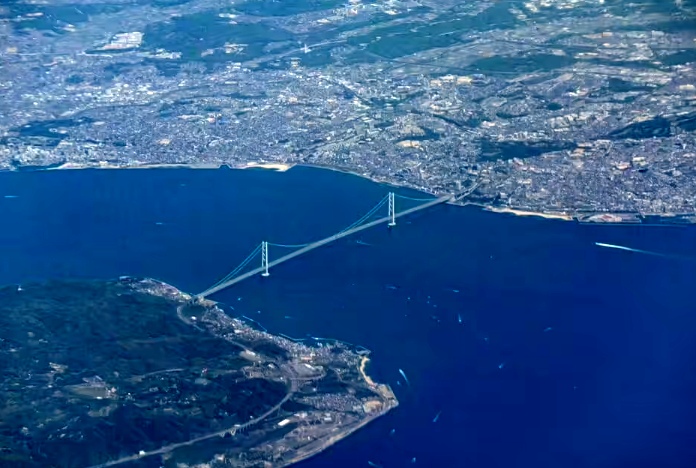The Akashi Kaikyo Bridge: A £2.8 Billion Marvel Linking Japan’s Islands
The Akashi Kaikyo Bridge, a 12,831-foot engineering marvel in Japan, spans the Akashi Strait, connecting Kobe and Awaji Island. Built over a decade at a cost of £2.8 billion, this suspension bridge—once the world’s longest—overcame earthquakes, typhoons, and tragedy-driven necessity. With a £12 toll, it links vital trade routes while symbolizing resilience and innovation.
NATIONAL ROADS AND MAINTENANCE
Phillemon Neluvhalani
4/9/20254 min read


Spanning an impressive 12,831 feet (3,911 meters), the Akashi Kaikyo Bridge—often dubbed the "Pearl Bridge"—stands as a testament to human ingenuity and resilience. Connecting the bustling port city of Kobe on Honshu Island to the quieter Iwaya on Awaji Island across the treacherous Akashi Strait, this suspension bridge took a decade to construct, from 1988 to 1998, at a staggering cost of ¥500 billion (approximately £2.8 billion at 1998 exchange rates). Today, it recuperates its hefty price tag through a toll of ¥2,300 (£11.95) per crossing, paid by thousands of motorists daily. But the story of this bridge is more than just numbers—it’s a tale of necessity, tragedy, and engineering triumph.
The Akashi Kaikyo Bridge wasn’t just a vanity project; it was a response to decades of peril. Before its construction, the Akashi Strait—a critical shipping route in Japan’s Seto Inland Sea—was served only by ferries. These vessels were notoriously vulnerable to the region’s volatile weather, including typhoons, gales, and unpredictable currents that could reach speeds of up to 4.5 meters per second. The strait’s dangers became tragically apparent in December 1945, when the overloaded ferry Sekirei Maru sank during a storm, claiming 304 lives—far exceeding its capacity of 100 passengers. The disaster sparked national outrage and planted the first seeds of public demand for a safer alternative.
A decade later, in 1955, two more ferry sinkings cemented the need for action. On May 11 of that year, a collision between two ferries in dense fog killed 168 people, including many schoolchildren, in what became known as the Shiun Maru disaster. These tragedies pushed the Japanese government to seriously consider a bridge. However, it wasn’t until the 1980s, after years of planning and feasibility studies, that construction finally began under the Honshu-Shikoku Bridge Authority (now part of the Japan Expressway Holding and Debt Repayment Agency).
Building the Akashi Kaikyo Bridge was no small feat. The project, which began in May 1988 and concluded with its opening on April 5, 1998, involved over 100 contractors and a workforce that braved some of the harshest conditions imaginable. The strait’s depth (up to 110 meters), strong tidal currents, and frequent seismic activity—owing to its proximity to the Pacific Ring of Fire—posed immense challenges.
The bridge’s two massive pylons, soaring 928 feet (282.8 meters) above sea level, required foundations sunk into the seabed using innovative techniques. Each pylon rests on a concrete caisson the size of a football field, carefully lowered into place amidst swirling currents. To ensure stability, engineers used specially designed steel cables—each comprising 36,830 strands and capable of withstanding winds of up to 178 mph (286 km/h). The central span, stretching 6,532 feet (1,991 meters), was the longest of any suspension bridge in the world at the time of its completion, a record it held until 2022 when Turkey’s 1915 Çanakkale Bridge, with a span of 6,636 feet (2,023 meters), surpassed it.
The bridge’s design also accounts for earthquakes, a constant threat in Japan. Just months before its completion, on January 17, 1995, the Great Hanshin Earthquake (magnitude 6.9) struck Kobe, killing over 6,000 people and causing widespread devastation. Remarkably, the unfinished bridge suffered only minor damage—a testament to its robust engineering—but the quake shifted the pylons slightly, lengthening the central span by about a meter. Engineers adapted, ensuring the structure’s integrity remained intact.
Today, the Akashi Kaikyo Bridge forms a crucial segment of the Kobe-Awaji-Naruto Expressway, one of three expressways linking Honshu and Shikoku, Japan’s fourth-largest island. Kobe, a vibrant metropolis and the country’s third-largest port after Tokyo and Yokohama, relies on the bridge for efficient trade and travel. On the other end, Awaji Island—known for its scenic beauty, historic sites, and agricultural produce like onions and citrus—has seen increased accessibility and economic growth since the bridge’s opening.
The bridge’s clearance of 215.6 feet (65.7 meters) below allows large ships to pass underneath, maintaining the strait’s role as a busy maritime corridor. Its six-lane deck accommodates around 23,000 vehicles daily, a figure that justifies the steep toll—equivalent to nearly £12 per crossing. While this fee has drawn criticism from locals and commuters, it’s part of a long-term strategy to offset the bridge’s colossal construction costs, which ballooned due to its complex design and the need to mitigate natural hazards.
Beyond its practical purpose, the Akashi Kaikyo Bridge is a source of national pride. Its sleek, elegant silhouette, often illuminated at night with a spectrum of colors, has earned it the nickname "Pearl Bridge" for its shimmering beauty. The structure has also become a tourist attraction, with a visitor center at its base offering insights into its construction and panoramic views from an observation deck.
The bridge’s legacy extends beyond Japan. It inspired advancements in suspension bridge technology worldwide and remains a benchmark for engineers tackling ambitious infrastructure projects in challenging environments. Though it lost its "longest span" title in 2022, its combination of scale, durability, and aesthetic appeal ensures its place among the world’s most remarkable feats of engineering.
At £2.8 billion (1998 valuation), the Akashi Kaikyo Bridge was one of the most expensive bridges ever built—a figure that, adjusted for inflation, equates to roughly £5 billion in 2025 terms. Critics argue that the toll, which has remained largely unchanged since 1998, places an undue burden on regular users. Yet, proponents point out that it has significantly reduced travel times—cutting the journey from Kobe to Awaji from an hour by ferry to mere minutes by car—while eliminating the risks that claimed so many lives in the pre-bridge era.
As of April 9, 2025, the bridge continues to stand tall, a vital artery in Japan’s transportation network and a symbol of what humanity can achieve when faced with nature’s toughest challenges.
Future
© 2024. All rights reserved.
